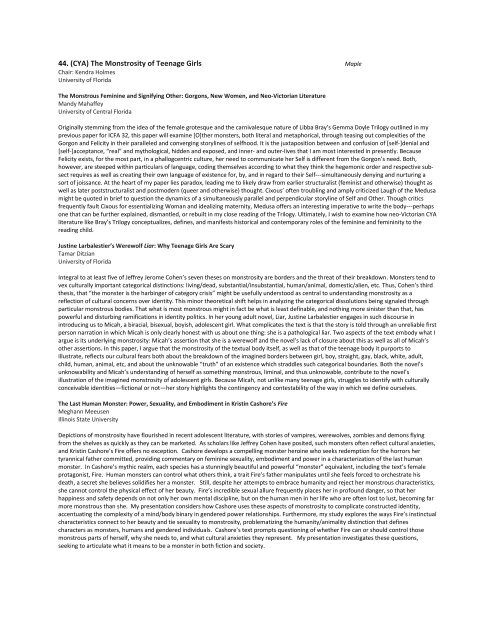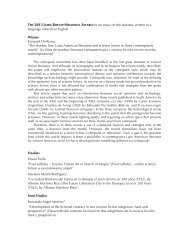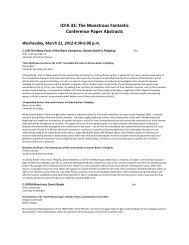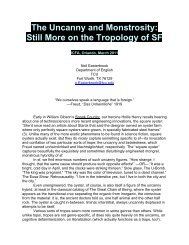The Monstrous Fantastic Conference Paper Abstracts - International ...
The Monstrous Fantastic Conference Paper Abstracts - International ...
The Monstrous Fantastic Conference Paper Abstracts - International ...
You also want an ePaper? Increase the reach of your titles
YUMPU automatically turns print PDFs into web optimized ePapers that Google loves.
44. (CYA) <strong>The</strong> Monstrosity of Teenage Girls MapleChair: Kendra HolmesUniversity of Florida<strong>The</strong> <strong>Monstrous</strong> Feminine and Signifying Other: Gorgons, New Women, and Neo-Victorian LiteratureMandy MahaffeyUniversity of Central FloridaOriginally stemming from the idea of the female grotesque and the carnivalesque nature of Libba Bray’s Gemma Doyle Trilogy outlined in myprevious paper for ICFA 32, this paper will examine [O]ther monsters, both literal and metaphorical, through teasing out complexities of theGorgon and Felicity in their paralleled and converging storylines of selfhood. It is the juxtaposition between and confusion of [self-]denial and[self-]acceptance, “real” and mythological, hidden and exposed, and inner- and outer-lives that I am most interested in presently. BecauseFelicity exists, for the most part, in a phallogcentric culture, her need to communicate her Self is different from the Gorgon’s need. Both,however, are steeped within particulars of language, coding themselves according to what they think the hegemonic order and respective subsectrequires as well as creating their own language of existence for, by, and in regard to their Self---simultaneously denying and nurturing asort of joissance. At the heart of my paper lies paradox, leading me to likely draw from earlier structuralist (feminist and otherwise) thought aswell as later poststructuralist and postmodern (queer and otherwise) thought. Cixous’ often troubling and amply criticized Laugh of the Medusamight be quoted in brief to question the dynamics of a simultaneously parallel and perpendicular storyline of Self and Other. Though criticsfrequently fault Cixous for essentializing Woman and idealizing maternity, Medusa offers an interesting imperative to write the body---perhapsone that can be further explained, dismantled, or rebuilt in my close reading of the Trilogy. Ultimately, I wish to examine how neo-Victorian CYAliterature like Bray’s Trilogy conceptualizes, defines, and manifests historical and contemporary roles of the feminine and femininity to thereading child.Justine Larbalestier’s Werewolf Liar: Why Teenage Girls Are ScaryTamar DitzianUniversity of FloridaIntegral to at least five of Jeffrey Jerome Cohen’s seven theses on monstrosity are borders and the threat of their breakdown. Monsters tend tovex culturally important categorical distinctions: living/dead, substantial/insubstantial, human/animal, domestic/alien, etc. Thus, Cohen’s thirdthesis, that “the monster is the harbinger of category crisis” might be usefully understood as central to understanding monstrosity as areflection of cultural concerns over identity. This minor theoretical shift helps in analyzing the categorical dissolutions being signaled throughparticular monstrous bodies. That what is most monstrous might in fact be what is least definable, and nothing more sinister than that, haspowerful and disturbing ramifications in identity politics. In her young adult novel, Liar, Justine Larbalestier engages in such discourse inintroducing us to Micah, a biracial, bisexual, boyish, adolescent girl. What complicates the text is that the story is told through an unreliable firstperson narration in which Micah is only clearly honest with us about one thing: she is a pathological liar. Two aspects of the text embody what Iargue is its underlying monstrosity: Micah’s assertion that she is a werewolf and the novel’s lack of closure about this as well as all of Micah’sother assertions. In this paper, I argue that the monstrosity of the textual body itself, as well as that of the teenage body it purports toillustrate, reflects our cultural fears both about the breakdown of the imagined borders between girl, boy, straight, gay, black, white, adult,child, human, animal, etc, and about the unknowable “truth” of an existence which straddles such categorical boundaries. Both the novel’sunknowability and Micah’s understanding of herself as something monstrous, liminal, and thus unknowable, contribute to the novel’sillustration of the imagined monstrosity of adolescent girls. Because Micah, not unlike many teenage girls, struggles to identify with culturallyconceivable identities—fictional or not—her story highlights the contingency and contestability of the way in which we define ourselves.<strong>The</strong> Last Human Monster: Power, Sexuality, and Embodiment in Kristin Cashore’s FireMeghann MeeusenIllinois State UniversityDepictions of monstrosity have flourished in recent adolescent literature, with stories of vampires, werewolves, zombies and demons flyingfrom the shelves as quickly as they can be marketed. As scholars like Jeffrey Cohen have posited, such monsters often reflect cultural anxieties,and Kristin Cashore’s Fire offers no exception. Cashore develops a compelling monster heroine who seeks redemption for the horrors hertyrannical father committed, providing commentary on feminine sexuality, embodiment and power in a characterization of the last humanmonster. In Cashore’s mythic realm, each species has a stunningly beautiful and powerful “monster” equivalent, including the text’s femaleprotagonist, Fire. Human monsters can control what others think, a trait Fire’s father manipulates until she feels forced to orchestrate hisdeath, a secret she believes solidifies her a monster. Still, despite her attempts to embrace humanity and reject her monstrous characteristics,she cannot control the physical effect of her beauty. Fire’s incredible sexual allure frequently places her in profound danger, so that herhappiness and safety depends on not only her own mental discipline, but on the human men in her life who are often lost to lust, becoming farmore monstrous than she. My presentation considers how Cashore uses these aspects of monstrosity to complicate constructed identity,accentuating the complexity of a mind/body binary in gendered power relationships. Furthermore, my study explores the ways Fire’s instinctualcharacteristics connect to her beauty and tie sexuality to monstrosity, problematizing the humanity/animality distinction that definescharacters as monsters, humans and gendered individuals. Cashore’s text prompts questioning of whether Fire can or should control thosemonstrous parts of herself, why she needs to, and what cultural anxieties they represent. My presentation investigates these questions,seeking to articulate what it means to be a monster in both fiction and society.





